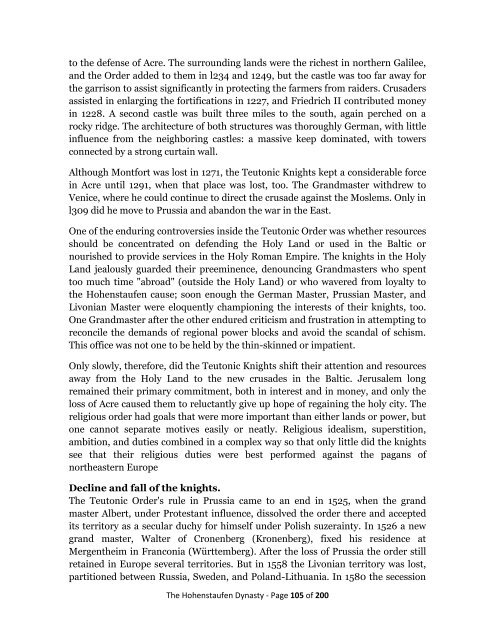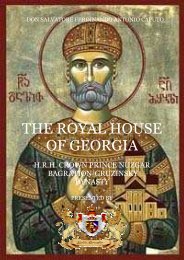here - Nobility Associations
here - Nobility Associations
here - Nobility Associations
Create successful ePaper yourself
Turn your PDF publications into a flip-book with our unique Google optimized e-Paper software.
to the defense of Acre. The surrounding lands were the richest in northern Galilee,<br />
and the Order added to them in l234 and 1249, but the castle was too far away for<br />
the garrison to assist significantly in protecting the farmers from raiders. Crusaders<br />
assisted in enlarging the fortifications in 1227, and Friedrich II contributed money<br />
in 1228. A second castle was built three miles to the south, again perched on a<br />
rocky ridge. The architecture of both structures was thoroughly German, with little<br />
influence from the neighboring castles: a massive keep dominated, with towers<br />
connected by a strong curtain wall.<br />
Although Montfort was lost in 1271, the Teutonic Knights kept a considerable force<br />
in Acre until 1291, when that place was lost, too. The Grandmaster withdrew to<br />
Venice, w<strong>here</strong> he could continue to direct the crusade against the Moslems. Only in<br />
l309 did he move to Prussia and abandon the war in the East.<br />
One of the enduring controversies inside the Teutonic Order was whether resources<br />
should be concentrated on defending the Holy Land or used in the Baltic or<br />
nourished to provide services in the Holy Roman Empire. The knights in the Holy<br />
Land jealously guarded their preeminence, denouncing Grandmasters who spent<br />
too much time "abroad" (outside the Holy Land) or who wavered from loyalty to<br />
the Hohenstaufen cause; soon enough the German Master, Prussian Master, and<br />
Livonian Master were eloquently championing the interests of their knights, too.<br />
One Grandmaster after the other endured criticism and frustration in attempting to<br />
reconcile the demands of regional power blocks and avoid the scandal of schism.<br />
This office was not one to be held by the thin-skinned or impatient.<br />
Only slowly, t<strong>here</strong>fore, did the Teutonic Knights shift their attention and resources<br />
away from the Holy Land to the new crusades in the Baltic. Jerusalem long<br />
remained their primary commitment, both in interest and in money, and only the<br />
loss of Acre caused them to reluctantly give up hope of regaining the holy city. The<br />
religious order had goals that were more important than either lands or power, but<br />
one cannot separate motives easily or neatly. Religious idealism, superstition,<br />
ambition, and duties combined in a complex way so that only little did the knights<br />
see that their religious duties were best performed against the pagans of<br />
northeastern Europe<br />
Decline and fall of the knights.<br />
The Teutonic Order's rule in Prussia came to an end in 1525, when the grand<br />
master Albert, under Protestant influence, dissolved the order t<strong>here</strong> and accepted<br />
its territory as a secular duchy for himself under Polish suzerainty. In 1526 a new<br />
grand master, Walter of Cronenberg (Kronenberg), fixed his residence at<br />
Mergentheim in Franconia (Württemberg). After the loss of Prussia the order still<br />
retained in Europe several territories. But in 1558 the Livonian territory was lost,<br />
partitioned between Russia, Sweden, and Poland-Lithuania. In 1580 the secession<br />
The Hohenstaufen Dynasty - Page 105 of 200



